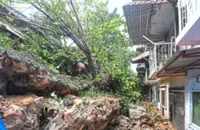Mahadi looking out at the city skyline and the Kuala Lumpur that he has had a hand in shaping.
AS KUALA Lumpur marks its golden jubilee as a Federal Territory, three former mayors recount their experiences helming the capital city to StarMetro.
The three immediate predecessors to current mayor Datuk Kamarulzaman Salleh highlight some of the transformative changes Kuala Lumpur has undergone over the past half century.
They also share their insights into the challenges that lie ahead, including urban renewal and creating job opportunities for Kuala Lumpur’s growing population.
The ex-mayors also list some of the achievements they are especially proud of during their tenure.
Q: What do you see as the city’s most significant transformation over the past 50 years?
Datuk Seri Mahadi Che Ngah (Oct 1, 2020 to March 31, 2023)
Seeing Kuala Lumpur’s transformation over the last 50 years is like witnessing a city reborn.
It all started with the first Kuala Lumpur Structure Plan in 1984, reshaping not just the infrastructure but the very soul of our city.
I remember the fragmented roads and basic drainage systems of the 1980s. Then, things changed.
We saw our road network evolve into an integrated system, connecting previously isolated areas like Wangsa Maju and Bukit Jalil.
These places transformed from outskirts into vibrant urban centres.
The public transportation overhaul was a remarkable leap towards sustainable and shared mobility.
The 1990s brought challenges, but we faced them head-on. Squatter settlements were transformed, uplifting entire communities.
Datuk Seri Nor Hisham Ahmad Dahlan (Oct 2, 2018 to Sept 30, 2020)
Born and raised in Kuala Lumpur, I have witnessed the city’s transformations first-hand.
The evolution has been vast and varied, encompassing urbanisation, overdevelopment, construction of highways and significant shifts in migration and population growth.
During my childhood, it was rare to see foreign workers in the city, whether they were there legally or not.
However, the atmosphere of Kuala Lumpur today is noticeably different.
The community in the city tends to lean towards materialism and individualism, a stark contrast from the past.
Tan Sri Mohd Amin Nordin Abdul Aziz (July 18, 2015 to Sept 30, 2018)
Having resided and worked in Kuala Lumpur for nearly 50 years, the most noticeable changes for me have been the evolving traffic patterns and the transformation of the city’s skyline.
Change is an inherent part of any growing metropolis responding to the needs of an expanding population. However, managing these demands effectively is crucial.
On a personal note, I find Kuala Lumpur more aesthetically pleasing now than it was years ago, thanks to the numerous parks and gardens.
Moreover, the rich cultural diversity of its inhabitants makes the city an attractive destination for tourists.
Q: What do you believe are the biggest challenges and opportunities facing Kuala Lumpur?
Mahadi: Kuala Lumpur stands at a crossroads of challenges and opportunities.
Sustainability emerges as a key focus, with the potential to achieve carbon neutrality.
Initiatives like transitioning to electric buses and embracing renewable energy sources are steps towards establishing Kuala Lumpur as a frontrunner in environmental stewardship.
Importantly, a revamped approach to stormwater management is critical.
Urban regeneration is pivotal for the future. As certain city areas show signs of ageing, they present opportunities for rejuvenation or complete redevelopment.
These transformations should prioritise sustainability, liveability and modern urban requirements while preserving heritage buildings and districts.
Additionally, acknowledging the city’s demographic shifts and projecting the population for the next 50 years is crucial.
Future planning extends beyond infrastructure; it encompasses fostering social, economic and environmental sustainability for coming generations.
Nor Hisham: Fostering citizenship, a sense of belonging and filial duty can significantly simplify our tasks if done correctly.
In today’s society, people are often caught up in a relentless pursuit of financial success, driven partly by the escalating cost of living, for which they cannot be faulted.
It is crucial for the authorities to address various issues, including welfare, infrastructure, safety, housing and traffic.
Government agencies should prioritise their services to ratepayers.
My vision is for a city mature enough to understand the importance of moving beyond politics, race and religion, and not succumbing to populist tactics.
Mohd Amin: The escalating cost of living, increasing job opportunities to match a growing population and intensifying traffic congestion are among the most pressing challenges faced by expanding cities.
Additionally the surge in vehicle ownership further complicates matters, with some households owning more than two cars and in certain cases, even exceeding four.
When it comes to job opportunities, there is an inevitable slowdown in development due to the scarcity of vacant land.
This reduction in construction activity leads to fewer work opportunities.
Therefore, it is crucial to learn how to effectively manage with the resources we have.
We could take lessons from cities like Singapore and Tokyo in city management.
Q: What accomplishments are you proud of during your time as mayor?
Mahadi: I made it a personal mission to conduct daily supervisory rounds, reflecting my deep commitment to Kuala Lumpur’s progress.
My most cherished memory is seeing the city, particularly Wangsa Maju, become a globally recognised city in combating climate change.
This area’s transformation into a Carbon-Neutral Growth Centre marked a significant achievement in green mobility, recycling and renewable energy.
I believe Wangsa Maju will serve as a model for future carbon-neutral initiatives.
Our strides in low-carbon initiatives have earned national and international recognition, including the 2022 C40 Cities Bloomberg Philanthropies Award and the Malaysia Institute of Planners’ (MIP) President’s Award.
Nor Hisham: My tenure as mayor began during a particularly unique and demanding period – the peak of the Covid-19 pandemic with the city in lockdown.
The role of Kuala Lumpur City Hall (DBKL) was critical in not only ensuring safety but also maintaining its operational continuity.
One of the most significant challenges we faced was the protection and rescue of a substantial number of homeless individuals who were at risk of exposure to the virus.
Additionally, my service as mayor spanned across two different governmental regimes.
It was imperative to remain focused on the mission of serving the community, regardless of the political landscape.
I also believe in the value of experiencing a city on foot.
To this end, I advocated for pedestrian-only zones, exemplified by my initiative to close parts of Jalan Tuanku Abdul Rahman, in front of landmarks like Sogo Kuala Lumpur and Masjid Jamek, to vehicular traffic.
Embracing pedestrian-friendly spaces is essential for the city’s vibrancy.
Mohd Amin: During my tenure, the crowning achievement was the development of affordable housing in Kuala Lumpur, a challenging feat given the reluctance of developers to construct three-bedroom units amid rising costs of materials like steel and cement.
Without subsidies or incentives, such projects are often unappealing to them.
However, we successfully built and completed over 50,000 units of affordable housing in the city.
Looking ahead, I foresee significant challenges for our younger population in home ownership over the next five to 10 years. Therefore, the focus should shift towards redeveloping older flats in the city.
Singapore encountered a similar situation years ago and managed to successfully redevelop many of their old housing projects to meet demand. It is time for us to follow suit.











